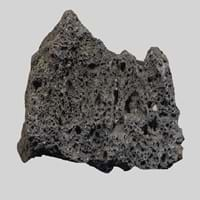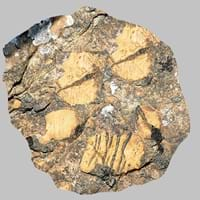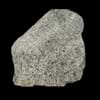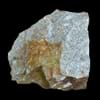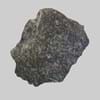Definition
Scoria is a dark-colored extrusive igneous rock with abundant round bubble-like cavities
Diamictite is a sedimentary rock that consists of non-sorted to poorly sorted terrigenous sediment containing particles that range in size from clay to boulders, suspended in a matrix of mudstone or sandstone
Origin
Unknown
Southern Mongolia
Discoverer
Unknown
Unknown
Etymology
From late Middle English (denoting slag from molten metal), from Greek skōria refuse, from skōr dung
From Greek dia through and meiktós or mixed
Class
Igneous Rocks
Sedimentary Rocks
Sub-Class
Durable Rock, Medium Hardness Rock
Durable Rock, Soft Rock
Group
Volcanic
Not Applicable
Other Categories
Fine Grained Rock, Opaque Rock
Coarse Grained Rock, Opaque Rock
Texture
Vesicular
Clastic
Color
Black, Brown, Dark Grey to Black, Red
Brown, Buff
Durability
Durable
Durable
Appearance
Glassy and Vesicular
Banded
Interior Uses
Decorative Aggregates, Interior Decoration
Decorative Aggregates, Interior Decoration
Exterior Uses
Garden Decoration, Paving Stone
As Building Stone, Paving Stone
Other Architectural Uses
Curbing
Curbing
Construction Industry
Cement Manufacture, Construction Aggregate, for Road Aggregate, In landscaping and drainage works
As Dimension Stone, Construction Aggregate, for Road Aggregate, Landscaping, Roadstone
Medical Industry
Not Yet Used
Not Yet Used
Antiquity Uses
Artifacts, Monuments, Sculpture
Artifacts
Commercial Uses
As a traction material on snow-covered roads, Creating Artwork, High-temperature insulation, In gas barbecue grills
Commemorative Tablets, Creating Artwork, Production of Lime
Types
Not Available
Bedded Diamictite and Laminated Diamictite
Features
Available in Lots of Colors and Patterns, Generally rough to touch, Surfaces are often shiny
Host Rock for Lead, Is one of the oldest rock
Archaeological Significance
Monuments
Used
Not Yet Used
Famous Monuments
Data Not Available
Not Applicable
Sculpture
Used
Not Yet Used
Famous Sculptures
Data Not Available
Not Applicable
Figurines
Used
Not Yet Used
Formation
Scoria forms when magma containing huge amount of dissolved gas flows from a volcano during an eruption.
Diamictite is unevenly sorted terrigenous, non-calcareous sedimentary rock which forms due to weathering of mudstone and sandstone.
Mineral Content
Apatite, Biotite, Calcite, Feldspar, Hematite, Hornblade, Ilmenite, Magnetite, Olivine, Pyroxene, Quartz, Silica
Calcite, Clay, Feldspar, Micas, Quartz
Compound Content
Ca, NaCl
Not Available
Types of Metamorphism
Burial Metamorphism, Cataclastic Metamorphism, Contact Metamorphism
Not Applicable
Types of Weathering
Biological Weathering, Chemical Weathering, Mechanical Weathering
Biological Weathering, Chemical Weathering
Types of Erosion
Chemical Erosion, Coastal Erosion, Glacier Erosion
Chemical Erosion, Coastal Erosion, Water Erosion
Grain Size
Fine Grained
Coarse Grained
Fracture
Conchoidal
Conchoidal to Uneven
Streak
White
Light to dark brown
Porosity
Highly Porous
Highly Porous
Luster
Subvitreous to Dull
Grainy, Pearly and Vitreous
Cleavage
Perfect
Not Available
Toughness
2.1
Not Available
Specific Gravity
Not Available
4.3-5.0
Transparency
Opaque
Opaque
Density
Not Available
2.2-2.35 g/cm3
Specific Heat Capacity
Not Available
Resistance
Heat Resistant, Impact Resistant, Pressure Resistant, Wear Resistant
Heat Resistant, Impact Resistant
Deposits in Eastern Continents
Asia
Afghanistan, Indonesia, Japan, Russia
China, India, Kazakhstan, Mongolia, Russia
Africa
Ethiopia, Kenya, Tanzania
Namibia, Nigeria, South Africa
Europe
Greece, Hungary, Iceland, Italy, Turkey
Austria, Denmark, Germany, Great Britain, Netherlands, Norway, Poland, Sweden, Switzerland, United Kingdom
Others
Not Yet Found
Not Yet Found
Deposits in Western Continents
North America
Bahamas, Barbados, Canada, Costa Rica, Cuba, Jamaica, Mexico, USA
Canada, USA
South America
Argentina, Chile, Ecuador, Peru
Brazil, Venezuela
Deposits in Oceania Continent
Australia
New Zealand, Western Australia
New South Wales, New Zealand
